A report out this week shows that there is no clear link between larger council size and better outcomes – with smaller councils often performing better across key measures.
Analysis by the District Councils’ Network (DCN) has been welcomed by local councils in Essex backing the creation of five new unitary authorities across the county, saying it provides compelling evidence in favour of their plan for smaller, more local unitary councils.
The DCN research reveals that larger councils don’t deliver better results—and in many cases, smaller councils outperform them. Across key metrics like financial sustainability, service quality, and value for money, smaller authorities consistently lead the way.
The research also dismantles the Government’s proposed 500,000 population benchmark for new unitary councils, finding no credible evidence to support it.
Meanwhile, residents in larger council areas are paying the price—literally. Band D council tax bills are on average £250 higher in areas with populations over 500,000. Yet bigger councils show no performance advantage and are more prone to financial instability, often relying on greater government support to stay afloat.
This evidence strongly supports the five-unitary model proposed by 10 out of 15 Essex councils, which is built on the principles of localism, strong community ties, and high-quality service delivery – and not focused on size. This proposal reflects real places and existing partnerships, ensuring that local government remains closely connected to the communities it serves.
Under the five-unitary model, Essex would be reorganised into five new councils with populations ranging from approximately 326,000 to 510,000. These include: North East Essex (around 510,000), West Essex (circa 326,000), Mid Essex (around 332,000), South West Essex (circa 369,000), and South East Essex (around 360,000). Each proposed unitary is designed to reflect natural communities and existing collaboration, while remaining well within the population range shown by DCN to deliver strong outcomes.
A joint statement from each of the 10 councils backing the five unitary model said: “We believe that effective local government is not about size—it’s about being rooted in place, responsive to local needs, and financially sustainable.
“The DCN’s findings reinforce our view that smaller, community-focused councils are best placed to deliver for residents.
“As the Government considers options for Local Government Reorganisation, we urge decision-makers to take this evidence seriously and remain open-minded about models that prioritise local connection over scale.
“Together, we remain committed to shaping a future for Essex that empowers communities, strengthens services, and puts local people at the heart of decision-making.”
Other options have been put forward for Greater Essex re-organisation: one proposing three unitary councils (of approximately 604,000, 564,000 and 729,000 populations); and two four-council models, one with population ranges of circa 325,600 to 640,900 and the other with a range of around 418,500 to 550,861.
The ten councils backing the five unitary model are: Basildon, Brentwood, Castle Point, Chelmsford, Colchester, Harlow, Maldon, Southend, Tendring, and Uttlesford.



